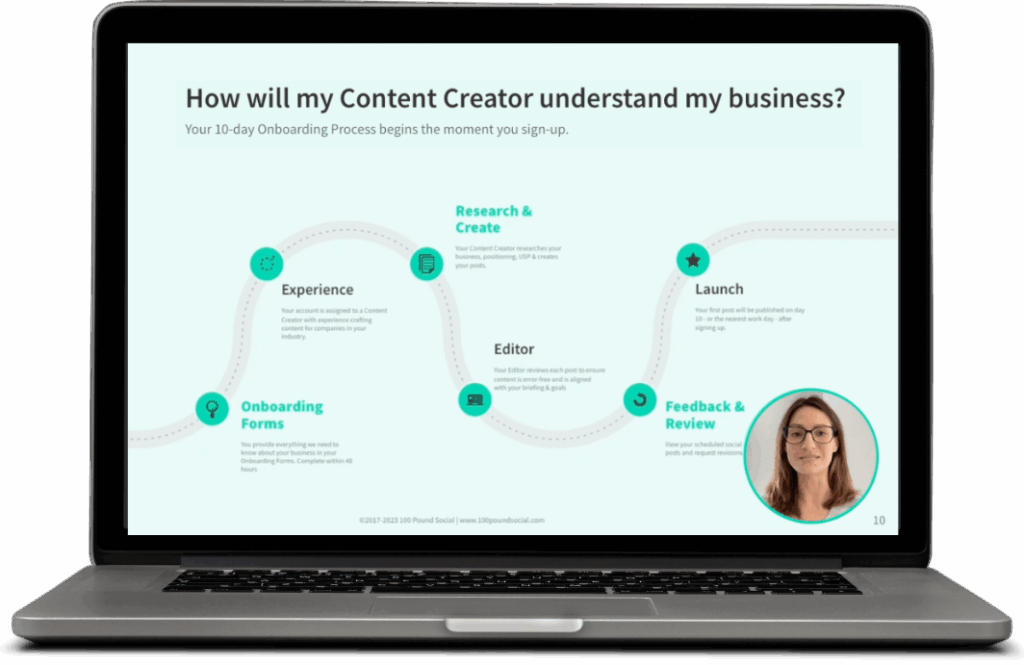Ever published a blog post that you thought was brilliant, only to watch it disappear into the internet void with barely a view or comment? Trust me, we’ve all been there.
After working with hundreds of B2B companies in consulting, finance, tech, marketing, and other professional fields, we’ve seen this frustration firsthand. You pour hours into creating content, hit publish, and then… tumbleweed.
The truth is, what makes a good blog post isn’t just good writing.
There’s a science to it – a set of key ingredients that separate posts that drive traffic, engagement and leads from those that just take up space on your website.
What Makes a Blog Post Successful?
Whether you’re handling content creation in-house or working with a specialised B2B content service, understanding these seven essential elements will help you transform your blog from a digital ghost town into a trust-building, lead-generating powerhouse.
Let’s break down what really matters and what makes a good blog post.
1. A Clear Purpose
The foundation of any effective B2B blog post – and what makes a good blog post in general – is a crystal-clear purpose.
Without this foundational element, even beautifully written content will fail to generate meaningful results. For professional service firms, purposeful content starts with answering some fundamental questions about who you’re trying to reach and what you want them to do.
One core aspect of what makes a good blog post, especially in B2B, is knowing exactly who you’re writing for. Most B2B companies we work with serve multiple buyer personas across different roles and departments. A financial consulting firm might need to speak to CFOs, controllers, and financial analysts—each with distinct concerns and levels of technical knowledge.
A software company likely needs different messaging for technical implementers versus the executives approving the purchase.
This specificity matters tremendously. When we help our clients in professional training develop content, we encourage them to visualise an individual reader and write as if speaking directly to that person’s situation.
This approach creates content that resonates on a personal level rather than feeling like generic industry commentary.
Beyond knowing who you’re writing for, effective B2B content requires clarity about the specific business outcome you’re pursuing.
Are you writing to generate awareness among new prospects?
To nurture existing leads?
To support current clients?
Each purpose demands different content approaches.
Understanding what makes a good blog post means matching content to a specific stage of the buyer’s journey. We worked with a SaaS company that was creating blog content without this clarity, and their posts received minimal engagement.
When we helped them reorganise their content strategy around specific purposes — top-of-funnel posts explaining industry challenges, mid-funnel posts comparing solution approaches, and bottom-funnel posts addressing implementation concerns — their engagement metrics improved dramatically.
Download Our FREE Blog Article Template here →
2. Compelling Headline
In the crowded digital space where B2B professionals consume content, your headline serves as the critical first impression. Think of it as the storefront sign for your ideas — it either draws readers in or sends them scrolling past.
For professional service firms competing for attention from busy executives and decision-makers, headline crafting deserves serious consideration.
But what separates effective B2B headlines from forgettable ones?
The most compelling headlines for professional audiences strike a careful balance between promising specific value and creating enough curiosity to warrant further reading. They signal relevance to the reader’s industry challenges while hinting at fresh perspectives or solutions.
Unlike consumer content that might rely on emotional triggers or sensations, B2B headlines for professional services should project credibility and expertise.
They should speak directly to business outcomes that matter to your target audience — whether that’s efficiency gains, compliance assurance, competitive advantage, or risk reduction.
When creating headlines for our clients across different professional service sectors, we’ve found that specificity almost always outperforms generality.
A headline that addresses a precise challenge, includes concrete numbers, or promises a clearly defined outcome consistently generates higher engagement.
3. Engaging Introduction
After your headline has succeeded in stopping the scroll, your introduction faces an equally critical task: convincing the reader that continuing is worth their valuable time.
For B2B professional audiences, this moment of decision carries particular weight. These readers aren’t casually browsing — they’re typically looking for specific information to solve business problems or inform decisions.
The introduction sets the contract with your reader.
It promises certain value and establishes both the tone and credibility of what follows. A strong introduction for B2B content accomplishes several things simultaneously: it confirms for the reader that they’re in the right place, it establishes your authority on the subject, and it creates a compelling reason to continue reading.
For professional service firms, introductions that connect directly with business challenges perform consistently better than general statements or academic observations.
When working with our consulting clients, we’ve found that opening with a specific, recognisable pain point immediately signals relevance to the target audience. The best introductions articulate the problem so clearly that readers think, “That’s exactly what we’re struggling with right now.”
Consider how different approaches might work across various professional sectors. A tech services company addressing IT security might open with a timely statistic about breach costs or compliance failures.
A financial services firm might begin with a regulatory change that’s creating uncertainty for its clients. A recruitment company might start with the particular hiring challenge their post will address.
The introduction also presents an opportunity to establish credibility without explicitly boasting.
Rather than claiming expertise directly, demonstrate it through the depth of understanding shown in how you frame the problem.
For example, a marketing agency writing about attribution challenges might open by naming the specific analytics limitations their clients frequently encounter, showing they’ve been in the trenches with this issue.
Length matters too.
B2B introductions generally benefit from being concise but substantive. Aim for 3-5 sentences that quickly establish context, acknowledge the challenge, hint at the solution approach, and create a reason to continue.
This is not the place for lengthy background or tangential information that delays getting to the core value.
4. Useful, Value-Packed Content
The main body of your blog post is where you deliver on the promises made in your headline and introduction – and where you begin to demonstrate what makes a good blog post truly effective. For B2B professional service firms, this is where trust is either built or broken.
While style and structure matter, ultimately, your content succeeds or fails based on whether it provides genuine utility to your professional audience.
Unlike consumer content that might entertain or inspire, B2B content for professional services must solve problems and inform decisions. Your readers are typically looking for insights that help them perform better in their roles, address specific business challenges, or make sound investments of their organisation’s resources.
They evaluate content based on its practical application to their work.
Another layer of what makes a good blog post is tailoring your insights to your audience’s specific needs. What constitutes “valuable” varies significantly across different professional service sectors. A procurement director reading content from a SaaS provider wants clear information about implementation requirements, integration capabilities, and total cost of ownership.
A CFO engaging with content from a financial services firm expects an honest perspective on regulatory implications, risk management approaches, or market trends affecting financial planning. Understanding these differing priorities helps you create truly useful content.
A key part of what makes a good blog post — especially in B2B — is the depth of insight it provides. Surface-level information that merely restates commonly known facts offers little value to professionals who are often already well-informed about their fields. Instead, aim to provide insights that go beyond what’s readily available through a quick search.
5. Clear Structure & Readability
Even the most valuable content will go unread if it’s not presented in an accessible way. For B2B professional audiences, structure isn’t just about aesthetics—it’s about respect for their time and cognitive load.
Well-structured content allows busy professionals to efficiently extract the information they need, increasing both the likelihood they’ll read your post and the value they’ll derive from it.
B2B decision-makers rarely consume content in a linear, start-to-finish fashion. Instead, their buying journey is highly non-linear and self-directed: buyers jump between channels and content types, revisit earlier stages, and engage with information in the order that best suits their unique needs and timelines.
Instead, they scan, jump between sections, and focus on elements that appear most relevant to their specific concerns. Effective B2B content anticipates and accommodates these behaviours through thoughtful structure.
Information architecture becomes particularly important in longer, more complex B2B content.
When we work with our financial services and consulting clients on substantive thought leadership pieces, we emphasise the need for clear organisational patterns that make navigation intuitive.
This might involve chronological organisation for process-oriented content, comparative structures for evaluation-focused pieces, or problem-solution frameworks for content addressing specific challenges.
Headings serve as the skeleton of your content, providing both navigational cues and cognitive breaks.
For B2B audiences, descriptive headings work better than clever or cryptic ones. A heading like “Implementation Timeline: What to Expect in the First 90 Days” immediately signals relevance to a reader concerned with project planning, whereas a creative but vague heading might be skipped entirely.
Subheadings further break down complex topics into digestible segments. For technical B2B content like that produced by SaaS companies or tech services firms, nested subheadings create a natural hierarchy that helps readers understand how concepts relate to each other.
This becomes especially valuable when explaining complex systems, methodologies, or technical specifications.
Paragraph length dramatically impacts readability, particularly for mobile readers who now make up a significant portion of B2B content consumption.
The optimal approach for professional service content typically involves varying paragraph length, with a preference for shorter segments (2-3 sentences) for key points and slightly longer ones (4-5 sentences) for more complex explanations.
This variation creates visual rhythm while preventing the cognitive fatigue that comes with dense text blocks.
Join a 15-Min Demo and See How 100 Pound Social Can Boost Your Business →
6. Optimised for SEO
Creating exceptional content serves little purpose if your target audience never finds it. For B2B professional service firms, search engine optimisation isn’t just a technical checkbox — it’s a key part of what makes a good blog post effective. It forms the crucial connection between your expertise and the professionals actively seeking solutions to the challenges you address.
Semantic SEO for B2B professional services differs significantly from consumer markets.
Decision-makers in consulting, finance, tech services, and other professional sectors often use search engines as research tools during extended buying journeys that might span months.
Their searches typically become more specific and technically nuanced as they progress from problem recognition to solution evaluation. Understanding this progression shapes an effective SEO strategy for professional service content.
Keywords for B2B professional services require particular attention to intent and specificity.
A term like “enterprise ERP implementation timeline for manufacturing” may have lower search volume than “ERP software,” but it represents a searcher much further along in their decision process and more likely to engage with substantive content.
Industry terminology plays a crucial role in B2B search visibility. Professional service firms often operate in sectors with specialised vocabulary that potential clients use when searching.
Financial services firms need to incorporate specific regulatory terms and compliance frameworks familiar to their audience. Recruitment companies benefit from including industry-specific role titles and certifications. Tech services providers should include precise technical specifications and compatibility terms.
The most effective approach combines topic expertise with search insights. Start by deeply understanding what your target clients need to know, then research how they search for this information.
Tools like SEMrush or Ahrefs can reveal the specific language your audience uses when seeking solutions you provide.
7. Strong Call to Action
The final essential element of an effective B2B blog post is perhaps the most commercially important — a clear, compelling call to action.
For professional service firms, the CTA represents the bridge between valuable content and business development. Without this critical component, even the most insightful content remains just information rather than a business-generating asset.
CTAs for B2B professional services differ fundamentally from their consumer counterparts.
While consumer content often drives toward immediate transactions, professional service CTAs typically focus on relationship development and trust-building steps appropriate to longer, more complex buying cycles. The goal isn’t usually an immediate sale but advancing the relationship to the next appropriate stage.
Understanding where your content fits into the buyer’s journey is essential for creating effective CTAs.
Top-of-funnel content for prospects just beginning to explore a topic might offer educational resources without requiring significant commitment. Middle-of-funnel content addressing specific methodologies might invite deeper engagement through assessment tools or consultations. Bottom-of-funnel content for prospects actively evaluating solutions should provide clear pathways to discuss specific services or implementations.
Putting It All Together
Creating effective blog posts for B2B professional service firms requires intentional attention to these seven essential elements.
By starting with a clear purpose, crafting compelling headlines, writing engaging introductions, delivering valuable content, using reader-friendly structure, optimising for search, and including strong calls to action, you create content that not only attracts the right audience but also moves them toward meaningful business relationships.
The most successful B2B firms don’t view blogging as a marketing checkbox but as a strategic business development asset that demonstrates expertise exactly when potential clients are seeking solutions.
Next Steps
Creating consistently high-quality blog posts while running your B2B professional service business can be challenging and time-consuming. 100 Pound Social is your solution.
With our extensive experience serving over 1,000 businesses across consulting, finance, tech services, marketing, professional training, SaaS, recruitment, and software, our UK-based team offers high-quality content tailored to your industry.
Our clients report increasing turnover, growing their professional networks, and signing new clients as a direct result of our content services.
Our Blog & Newsletter Plan provides expertly crafted blog articles that incorporate all seven essential elements discussed in this guide.
Join a 15-min demo to discover how we can help you create effective blog content for your professional service business – from just £120 per month. During this free demonstration, you’ll:
- Get a general overview of how our Blog, Social Media & Newsletter Plans work
- Learn about our expert UK-based team and the process behind our content creation
Or click here to book a call with our expert team.






